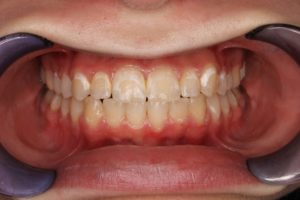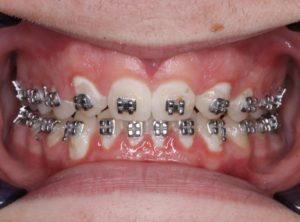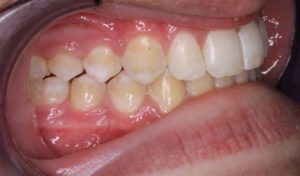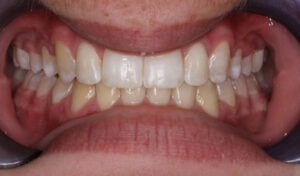I can remember every broken heart in my life. All unique in their own right but in the end, all of them the same. All of them, of course, ending in white spot lesions.
Ok, I’m am probably sounding a little dramatic here but ONLY just a little. And what is a white spot lesion? I will explain more in detail. To summarize, it is the initial stages of a cavity that turns white and stays white (Figure 1). Think of it as a tooth scar! And then take a moment to think about the time you spent in braces. Think about your efforts and your dedication to your braces, your smile, and to yourself over the past 1-2 years. Think about the commitments that your parents have made to help you have a healthy smile. Think about your poor orthodontist who helped to artfully craft a masterpiece only find at the unveiling someone had poured glitter all over it. Yes, I am playing a victim here for a second but I wanted to emphasize how important it is to avoid the dreaded white spot lesions. Therefore, my focus today is to discuss what white spot lesions are, why they occur, and the many options that we have to avoid them.
What is a White Spot Lesions?
Figure 1 This is an example of White Spot Lesions. Notice the “halo” that has formed around the area that the braces use to be on. We had to take the braces off earlier than we would have liked to prevent the lesions from getting worse. These were cause from poor diet and hygiene while the braces were on. This is 2 weeks after taking the braces off and they will improve with time.
A white spot lesion is essentially the beginning of a cavity! The enamel of a tooth is made of a very dense material, similar to bone. This dense material is made up of a lot of minerals, the majority being calcium. White spot lesions are often called decalcification or “decal” if you’re in the biz. Decalcification means the calcium is being taken away from the tooth. Since the enamel is made out of a large part calcium, holes are formed in the tooth when the calcium leaves.
The thing that strips the calcium, or decalcifies, the teeth is acid! I know that sounds crazy but how do you think acid could get into your mouth? Yes, bacteria create the acid and hence create an acidic environment. Why do bacteria create acid? It is a biproduct (scientific way of saying going to the bathroom) that comes out when they eat sugars. And how do you think bacteria could get sugar? You give it to them! When you eat, they eat. I think this is great new because YOU are in complete control! If you are not in control, keep reading as there are a few more tips ahead.
Figure 2 This is a young man that returned to our office after being gone for several months. You can see the food and plaque that has accumulated around the braces from improper or lack of brushing. I want to assure you that this is not how the majority of patients with braces look but it is the reality of what happens when patients do not brush. These braces were removed immediately and this patient was sent back to his dentist for a thorough cleaning.
What is NOT a WSL?
Figure 3 This is an example of enamel hypocalcification that comes about during the development adult teeth. This young man had this appearance of his teeth before he had braces on. Notice how it is spread evenly throughout the teeth in contrast to the photos shown in figure 1 and figure 2.
I do not want to confuse anyone here. Teeth are white, so why should I be afraid of white spots on my white teeth? Revisiting our scar analogy, a scar is often a similar color to your skin but it is very evident that it is different. It can really have an impact of the esthetics of your front teeth. More importantly, these are early cavities and can sometimes turn brown or black after a while. So, should you be afraid of every white spot on your teeth? The short answer is no. We can have white spots or discoloration of our teeth that are not caused by poor hygiene and decalcification. Let’s briefly review what some of these “Not white spot lesions” are so that you can get some sleep tonight.
There are some white spots (notice I do not use “lesion” here) that are formed during development. When your teeth are being made, there are some things that can have an influence on the formation of them. You are essentially born with these types of white spots. We will classify these into two types: Dental Fluorosis and Enamel Hypocalcification.
Dental Fluorosis is associated with cumulative fluoride intake during enamel development. When is enamel developing? From birth to the age of 8 with the greatest risk for fluorosis being 15-30 months of age. It can range in degree and vary in appearance. The good news is, it actually makes your teeth more resistant to cavities! I want to be clear that I am not discouraging fluoride use here. It has great benefits and should be used at the recommended intake. If you want to learn more check out this link from the American Academy of Pediatric Dentist or comment below! I would love to chat in more depth about this.
Enamel Hypocalcification (Figure 3). Let’s carefully compare this word to one we had previously discussed, decalcification. “Hypo-” before a word means less than normal while “De-“ indicates removal or separation. Therefore, hypocalcification means that the teeth were made with less calcium. Again this is during development of our teeth and can be caused by a number of events such as injury to the developing teeth or infection of baby teeth. It could even be caused by high fevers, illnesses, or nutrient deficiencies that may occur during the development of the teeth. Enamel hypocalcification is typically not bad for the teeth but it can compromise the esthetics of the teeth in severe cases.
What causes White Spot Lesions?
White spot lesions can become more prevalent during orthodontic treatment, but I want to stress that braces do not cause White Spot Lesions! Accumulation of plaque from not cleaning your teeth is what causes White Spot Lesions. As dental plaque begins to accumulate on your teeth and around the braces, an acidic environment is created if it is not cleared away. In this acidic environment, bacteria that causes cavities begins to thrive and they create more acid that makes holes in your teeth. If you’re really into science and you would like to know how this process works in more detail, please share your questions! I would love to discuss this in more depth but for now I will move forward.
What do we do about White Spot Lesions if they do occur?
If you’re like most of us, we let or guard down at times. May children do not worry about consequences. That’s ok sometimes, it’s how we grow. In this case, I would much rather do everything in my power to help you avoid that growing pain. I don’t mean to pick on children because this can happen to anyone who does not clean their teeth as well as they should. If you’re one of those people then the good news is we can improve these lesions with natural remineralization, applying fluoride, applying MI Paste, resin infiltration, or cosmetic restorations. I am not going to waste my energy on these topics here and neither should you because there is only one treatment worth directing our focus to and that is PREVENTION! Prevention is hands down the greatest (and cheapest) way to tackle White Spot Lesions.
Prevention can be very simple. It all starts with education! When you have braces on (or even if you do not) it is critical that you stay away from foods that are high in sugar as these are the ones that really get those bad bacteria going. A lot of sport drinks are high in sugars and are commonly sipped on during the day. Candy of course is a big NO. Simple carbs such as crackers and white bread are broke down into sugar if they are allowed to stay in the mouth and between the teeth long enough. I would argue that diet is the most critical part of prevention. Try to stay to vegetables and complex carbohydrates such as whole grains.
Following diet in the hierarchy of prevention is hygiene. This should be no surprise. You hear your dentist talk about brushing and flossing every day. I’m going to back my homies up on this one. This must be done with or without braces! The aim for brushing and flossing is to remove the food debris that is used by those harmful bacteria that create cavities and cause the gum disease gingivitis. The most common question is how long should I be brushing? The only answer to that should be, “until your teeth are clean.” It is the quality rather than the amount of time that is important in brushing and flossing. Your dental or orthodontic team would be happy to show you strategic ways to angle your brush and efficiently use your floss to make hygiene easy. I will not begin to type you through this as it is best learned visually but if you have any concerns please reach out here and I will set up a skype session and walk you through it. Finally, you may be the best brusher in the world (I will challenge you via Skype) but we all need professional help. You need to continue to see your general dentist and hygienist every 6 months, if not more, to have them professionally clean your teeth.
Fluoride has been controversial in the media throughout the past few years. If you do well with your diet and hygiene, then you will do just fine without fluoride anyways. After looking closely at the peer-reviewed articles on the topic I am still in the “Use Fluoride” camp. This doesn’t mean that you must be! I respect everybody’s thoughts, opinions, and wishes. In fact, I would love to be convinced otherwise as I think it is healthy to questions the status quo. Until then, I will advise you to use fluoride as it helps to remineralize the demineralized teeth. It also serves to inhibit the growth of those harmful bacteria that we mentioned earlier. Fluoride is found in most over the counter toothpaste but if you are in need of something stronger, there are several fluoride toothpaste and mouthwashes out there that will help.
What is Lifetime Orthodontics doing to prevent White Spot Lesions?
Screening. One of the first things we look at when you come in for a new patient exam, is your hygiene. Generally, when you have poor brushing and flossing habits, they continue as they are, or they get worse once we get braces on. Let’s not fool anyone. While orthodontic treatment can significantly improve your quality of life, I have yet to see a smile that has put anyone in a life or death situation. Your general oral health is our foundation and if we do not have a stable foundation, it is not a good idea to begin orthodontic treatment. We therefore screen for those that we think might be at higher risk for white spot lesions and expend more energy on them before we even get started. If we see anything in question we work with you, your dentist, and your hygienist to educate and do whatever it takes to get your foundation strong.
Fluoride. Every patient that gets braces in our practice gets a toothpaste called Prevident 5000. Prevident is a toothpaste that requires a prescription and that has a high (but safe) concentration of fluoride in it. More than you would find in your average toothpaste. We advise patients to use this every night after eating their last meal. We ask that they “massage” the toothpaste into all the teeth and rinse minimally to let the fluoride really soak in and strengthen the teeth. We also have a fluoride varnish that we apply in the office to those who look like they are having a tough time.
Pro Seal. This is a product from a company that we order our adhesives from. If during our screening we think that you may be at an increased risk for White Spot Lesions this comes highly recommended. What it is, is a thin layer of adhesive that goes over the teeth and “seals” them. It is an added layer of protection that we especially like to use on your front teeth. Think about your screen protector on your phones! This product is very expensive but made available to you at no cost if it will help avoid any post-braces “heartbreak”. Please ask us about this at your consultation if you are interested in learning more.
Clear Aligner Therapy. This is a form of treatment that allows us to deliver the beautiful smile you deserve without the metal braces and wires. It is a series of clear retainers that you can remove to eat and brush. There are several companies that we use to provide clear aligner therapy but the most common and well known is Invisalign. Why might this be beneficial in decreasing our risk for White Spot Lesions? It eliminates the obstacles (braces and wires) that make it difficult to clean your teeth. You must wear these aligners 24/7 except to brush and eat but when you do brush and eat they can come off! These means you can easily floss and easily brush. Food debris is not as likely to get stuck in your wires or around your braces. If we think you might be at higher risk for White Spot Lesions, we will highly recommend aligners in most cases. While not everyone is a candidate for aligner therapy, the advances in technology and Lifetime Orthodontics’ investment in improving their aligner capabilities has significantly broadened the type of cases that can be treated with aligners.
Like most things, we cannot go through life being afraid of White Spot Lesions. For each of the aforementioned “heartbreaks” that I have endured, I have endured 100 times more beauty, bliss, and joy! We live and we learn. For this reason, we have learned to make the prevention of White Spot Lesions a top priority in our practice. I know a lot of us like to learn the hard way. So, if that is you then no worries. Please come in or just send us a picture of your area of concern and we would be happy to talk about the treatment options available to you.
“Treatment without prevention is simply unsustainable.” – Bill Gates.
Happy Holidays!
Gerald W. Wesley DDS, MS




